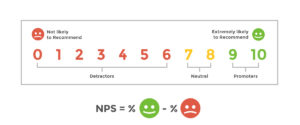There’s a saying in business: if you can’t measure it, it never happened. But how do you measure satisfaction? Luckily, there’s a measure for that, too: customer satisfaction metrics. Customer satisfaction quantifies the degree to which a customer is pleased by a product, brand, or overall experience.
If you don’t measure customer satisfaction, you may be blindsided by customers who churn or discourage others from working with you. Therefore, you should not only track customer satisfaction, but you should also empower your customer success team to take action based on the lessons these metrics teach you, customer satisfaction metrics.
How to Track Customer Satisfaction with NPS
Customer satisfaction metrics keep an eye on how customers are responding to your initiatives and whether any customers need support. Of course, happiness is subjective, so customer satisfaction must be rated along a continuum. That’s why the Net Promoter Score (NPS) is a key metric to track. It is an index that assigns customers a score from one to ten. NPS is calculated using a specific formula that draws on data from customer satisfaction surveys.

Customers who rate as high as nine or ten are your promoters, meaning they are so positive and vocal about your brand that they may spread good word of mouth. Customers who score seven or eight are neutral and won’t say much about your brand either way. And customers who score anywhere from one to six are detractors. They are unhappy with your brand and may try to dissuade others from buying your product. Identifying the promoters, neutrals, and detractors among your customer base is a powerful tool.
Once you have NPS scores for your customers, you must consider that data in context in order to get a clear idea of what to do next. Gather all your data, then combine individual metrics to create an overall picture of the customer base.
You can also break customers out into NPS segments to identify trends. For example, are low-scoring customers using older software versions? Have they not realized the value of new features that could solve their problems? Are these customers from the same industry or in the same stage of the customer journey?
Here are a few ways to analyze the data around NPS scores:
- Track customers’ NPSs to identify any that are at risk of churning.
- Segment users based on NPS scores, industry type, feature usage, stage of the customer journey, or other common data points.
- Identify how many support or help desk tickets have been opened or are currently open. Look for patterns that may reveal causes of low customer satisfaction.
- Document how long onboarding takes. If it’s taking too long, customers may experience a slow time to value, which results in poor satisfaction rates.
- Measure how customers are progressing through their customer journey. Are they currently in multiple customer journey stages at one time, have outstanding support tickets, or low license usage?
Armed with this information, you can identify your areas of improvement and make a plan to increase customer satisfaction.
Best Practices for Improving Customer Satisfaction NPS Scores
If you discover customers who have low NPSs, don’t despair. Here are some best practices you can use to improve customer satisfaction:
Track Progress
You need to keep a close eye on your customers at all times. As such, you should enable an early warning system to track how customers are progressing through their journey and look for any changes in customer satisfaction metrics. By doing this, you will understand your customer’s progress and can effectively take action to add value and boost satisfaction rates.
Establish an Action Plan
It’s important that your team knows how to act based on customer satisfaction metrics. So, develop standardized action plans that make it clear what role everyone will play. These plans should breakdown the process into steps so that different team members can easily repeat the process. You should also make more information available for your team and place them in an accessible location in case they need more support on a certain campaign.
Set up standardized next steps for your team to follow based on specific NPS scenarios. For instance, if a customer has a score of 9-10, your team should reach out for reviews, testimonials, or case studies. For customers who fall in the neutral category, direct them to community channels for support. When you find a detractor, have a CSM reach out to set up a time to meet.
Reach Out and Engage Intelligently
When you find the causes of low Net Promoter Scores, improve them by implementing targeted campaigns based on your customer’s goals. Compose a specialized message and present it to customers in a series of communications. For example, if a customer scores over a nine, a CS manager might reach out to the customer thanking them for working with the enterprise and asking for a reference.
When creating your campaign, ask some analytical questions:
- Can you segment customers based on trends?
- Why did customers give a low NPS score?
- What areas need improvement?
- Do customers need additional educational resources?
Measure Results
Consider what actions you have taken since gathering information about NPS scores and how effective they were. For instance were you able to increase customer advocacy by adding more people to your segment for review targeting? Did you increase adoption after reaching out to offer more support? How has your enterprise benefitted from these actions? Answering critical questions will help you create intelligent campaigns that address the right customer pain points.
Improve the Efficiency of Your Customer Success Operations
If you do not provide enough support throughout the customer journey, customers may feel unsupported. Be sure you are using standardized processes designed to be as effective as possible. Here are some ways to ensure you’re working smarter, not harder:
- Update your standardized processes for onboarding, escalation management, or features within your product based on customer feedback.
- Think about how you engage customers. Engagements should be personalized, thoughtful, and proactive.
- Revamp the way you send educational messages, such as by adding new videos or documents. Make sure training considers which features will be most useful in helping a particular customer achieve their business goals.
- Iterate your processes. Review customer feedback to identify bottlenecks or potential feature updates, make those adjustments and track their effect on your customers journey.
By optimizing your process, you can provide better support for customers.
Automate to Scale
You can set up an early warning system and trigger tasks based on events that you’ve identified as significant. Automation ensures that nothing slips through the cracks and your teams know the exact steps to take when following up with clients.
Here are some ways to make the most of automation:
- Create sentiment reports. These reports identify at-risk customers and potential advocates. Identify a threshold, such as an NPS score of six, and tag them as “at-risk.” Assign them to customer success managers for follow-up.
- Track customer data and be proactive. Collect customer feedback. Based on the data you receive, implement product updates to improve the customer experience or adjust standard processes. Make feedback data, as well as any other internal notes, accessible to all members of your organization.
By automating responses and creating standardized workflows, you can be confident that every customer hears from you, no matter how many customers you have. When NPS scores are low, the last thing you want to do is overlook a customer who may be on the verge of churn.
The Right Solution to Increase Customer Satisfaction
If you want to improve customer satisfaction, empower your customer success team with the technology they need to do so. For instance, customer success software makes it possible to stay informed on the satisfaction levels of a large number of customers. Capabilities like organization-wide access to data, timely responses, and the ability to set and track goals at every stage of the customer journey make this software incredibly useful. It’s the best way to drive value for your customer and your organization.
After all, if customers become unhappy, they have the power to leave your brand for a competitor. It is important that you make customer satisfaction a key priority so you can retain customers for life.
Totango offers all the capabilities your customer success team needs to track customer data and interact intelligently. Request a demo to see how our customer success platform makes it easier to monitor and use customer satisfaction metrics such as Net Promoter Scores. To learn more, explore Spark.

